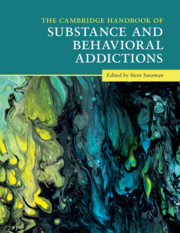Book contents
- The Cambridge Handbook of Substance and Behavioral Addictions
- The Cambridge Handbook of Substance and Behavioral Addictions
- Copyright page
- Contents
- Figures
- Tables
- Contributors
- Foreword
- Preface
- Acknowledgements
- Part I Concepts of Addiction
- Part II Clinical and Research Methods in the Addictions
- Part III Levels of Analysis and Etiology
- Part IV Prevention and Treatment
- 15 Adolescent Drug Misuse Prevention: Challenges in School-Based Programming
- 16 Treatment of Alcohol, Tobacco, and Other Drug (ATOD) Misuse
- 17 Prevention and Treatment of “Food Addiction”
- 18 The Prevention and Treatment of Gambling Disorders: Some Art, Some Science
- 19 Prevention and Treatment of Sex Addiction
- 20 Passionate Love Addiction: An Evolutionary Survival Mechanism That Can Go Terribly Wrong
- 21 Prevention and Treatment of Compulsive Buying Disorder
- 22 Prevention and Treatment of Work Addiction
- 23 Gaming Disorder and Its Treatment
- Part V Ongoing and Future Research Directions
- Index
- References
16 - Treatment of Alcohol, Tobacco, and Other Drug (ATOD) Misuse
from Part IV - Prevention and Treatment
Published online by Cambridge University Press: 13 July 2020
- The Cambridge Handbook of Substance and Behavioral Addictions
- The Cambridge Handbook of Substance and Behavioral Addictions
- Copyright page
- Contents
- Figures
- Tables
- Contributors
- Foreword
- Preface
- Acknowledgements
- Part I Concepts of Addiction
- Part II Clinical and Research Methods in the Addictions
- Part III Levels of Analysis and Etiology
- Part IV Prevention and Treatment
- 15 Adolescent Drug Misuse Prevention: Challenges in School-Based Programming
- 16 Treatment of Alcohol, Tobacco, and Other Drug (ATOD) Misuse
- 17 Prevention and Treatment of “Food Addiction”
- 18 The Prevention and Treatment of Gambling Disorders: Some Art, Some Science
- 19 Prevention and Treatment of Sex Addiction
- 20 Passionate Love Addiction: An Evolutionary Survival Mechanism That Can Go Terribly Wrong
- 21 Prevention and Treatment of Compulsive Buying Disorder
- 22 Prevention and Treatment of Work Addiction
- 23 Gaming Disorder and Its Treatment
- Part V Ongoing and Future Research Directions
- Index
- References
Summary
Approximately 23.5 million people in America need assistance for an alcohol, tobacco, or other drug use (ATOD) disorder, although many do not obtain the help that they need. This disorder is extremely difficult to resolve, as it can be hard to make the necessary lifestyle changes to accommodate sobriety. Sometimes, individuals may recover without formalized treatment, otherwise known as natural recovery. Other times, inpatient or outpatient treatment, or partial-hospitalization, is warranted. Even for individuals taking the proper steps and going to treatment, attrition rates are high, with consistent drop-out rates of 30 percent to 40 percent within three months of treatment initiation. Racial and gender disparities in both treatment participation and outcomes exist, indicating a need for tailoring of treatments and further research on breaking barriers to treatment entrance. Motivation is central in several recovery models proposed to explain stages of change in treatment. Treatment options include initial detoxification and pharmacological options (such as medication-assisted treatment using buprenorphine for opioid use disorder), cognitive-behavioral therapy, motivational interviewing, cue exposure, attentional retraining, twelve-step programs, and group/family therapy. Relapse rates are high, and oftentimes individuals move from one addiction to another. Harm reduction approaches may be beneficial to those that cannot fully quit an addiction, and relapse prevention is an important treatment component, as addiction is a life-long battle.
Keywords
- Type
- Chapter
- Information
- The Cambridge Handbook of Substance and Behavioral Addictions , pp. 215 - 229Publisher: Cambridge University PressPrint publication year: 2020
References
- 2
- Cited by

